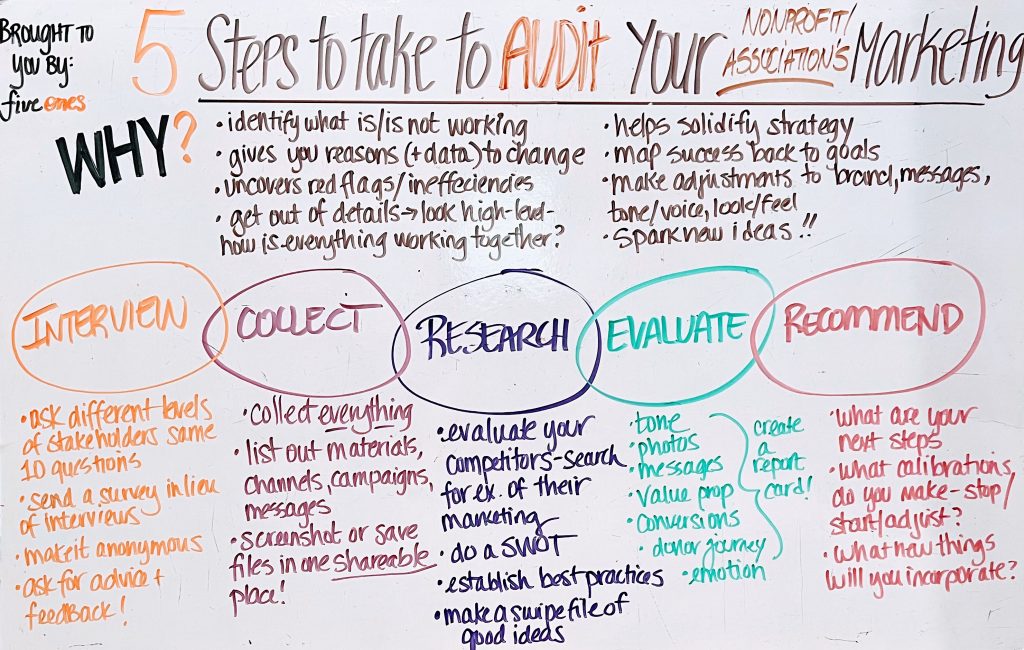5 Steps to Take to Audit Your Nonprofit or Association’s Marketing
Hi! Welcome to the latest episode of The High-Five Nonprofit Marketing Ideas. I’m Julia McDowell, Marketing Strategist for Five Ones. The High-Five is my video series of marketing strategies and tactics for nonprofits and associations. When you hear the word audit, you may think of taxes and have an immediate negative reaction. Don’t worry! This type of audit has nothing to do with taxes and everything to do with understanding what you’re currently doing and what’s working and what’s not in your marketing efforts.
In fact, a marketing audit has many benefits. Not only does it help you identify what’s working and what isn’t, but it also helps you flag any issues before they become major problems, solidify aspects of your marketing strategy, and build a solid foundation to continue to work off of. And here’s one sobering stat for you, creating six pages of content can emit as much carbon as making a smartphone. So, auditing your online messaging is not only smart, it is a responsibility!
You can conduct your own audit, but it also might help to get an outsider’s perspective. They can help support your takeaways, as well as add-in ideas they see from the industry as a whole. Let’s dive into the steps of an audit. You can do this!

Interview
People are your best resource. Whether they’re on your team or not, give them space to honestly and freely discuss their thoughts and opinions on your current marketing efforts. Either record their answers or bring a laptop or notebook to jot down notes.
And really listen to what they have to say. It can be hard, especially if you’re on the same team, to take constructive criticism, but by doing so, you’ll only make your team better.
It can also help to send an anonymous survey to get true, unbiased feedback. Set opening and closing dates and then allow for free-form answers so people don’t feel boxed in.
Collect
Next, you get to dive into what is currently being used as far as materials, documents, and technology is also key.
Are you using an email system that is expensive and doesn’t have a key feature you need?
Is the messaging on some of your materials outdated?
Look at everything you’re using and create folders of materials that are in good shape and ones that need to be updated.
Then, create a list of all of the marketing channels you’re using. This could be websites, subscriptions, apps, etc. Write down when you last used it or the cadence in which you use it to ensure you’re getting your money’s worth, and also write down what it does well or what you wish it did. You’re essentially creating to-do lists for yourself.
Research
You should definitely incorporate some additional first-hand research into your audit. Evaluate your competitors. What do you like that they are doing? What piques your interest? What doesn’t? This can help you form a list of best practices that you can use in the next step.
Or do a SWOT analysis – looking on the outside can give you more insight into what recommendations you’re going to have at the end of this exercise.
Evaluate
Now, get ready, because you’re now allowed to be your own worst critic.
I find it helpful to create a score or report card for each marketing piece and parameters for evaluation. Something as simple as a chart with 3-columns that identifies 1) what element you’re looking at 2) best practices and 3) your analysis, can do the job.
Some things you can address here are:
- Are your tone of voice, photography, personality, logo and graphics, images and colors, typography, and fonts consistent and up to date?
- Does your messaging and external communication strategy have a great value proposition?
- How do you want to convert someone? Or not. It is through downloads, subscriptions, donations, purchases, etc.?
- Who are you targeting? Is your content relevant to that audience at every step of the customer journey? Are you using the right channels?
- Are your communications strategies emotional enough? Does your tone resonate with your target audience?
Then look at the results from measurable marketing activities, like social media campaigns, media coverage, or fundraising drives. Ideally, you could put this in a spreadsheet where you can track your big numbers over time. Then, for each channel or initiative, you can answer questions like (this one pertains to a social media campaign):
- Why does one post have more likes than another?
- What is the type of content that had more engagement – video vs. picture?
Recommend
After you’ve evaluated all of the aspects of your marketing efforts, you have to come up with a plan for moving forward. You just spent a lot of time evaluating, but it doesn’t mean anything unless you assign action items and have a larger plan. Give yourself time to sit all of your evaluations, but have a roadmap for tweaking, altering, or completely overhauling certain areas of your marketing. Writing down the plan can help hold yourself accountable, and identify the resources and expertise of others that you’ll need to make things happen.



